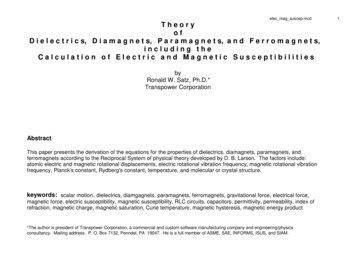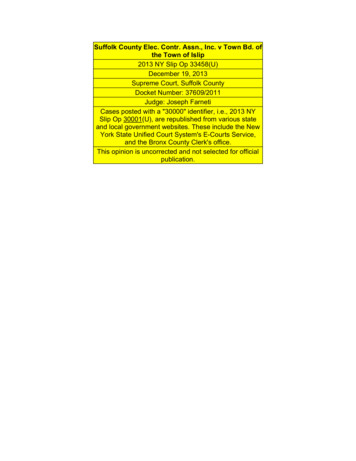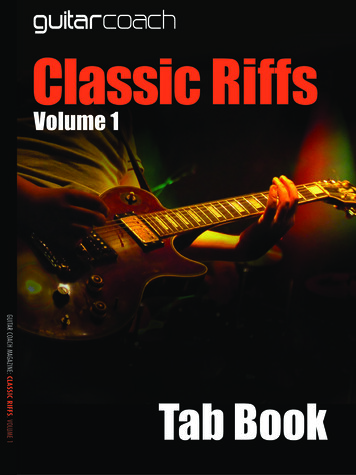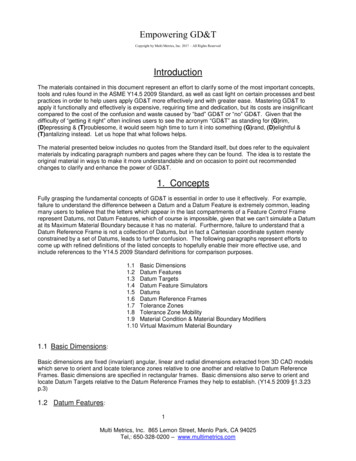
Transcription
elec mag suscep.mcdTheoryofD i e l e c t r i c s, D i a m a g n e t s, P a r a m a g n e t s, a n d F e r r o m a g n e t s,including theCalculation of Electric and Magnetic SusceptibilitiesbyRonald W. Satz, Ph.D.*Transpower CorporationAbstractThis paper presents the derivation of the equations for the properties of dielectrics, diamagnets, paramagnets, andferromagnets according to the Reciprocal System of physical theory developed by D. B. Larson. The factors include:atomic electric and magnetic rotational displacements, electric rotational vibration frequency, magnetic rotational vibrationfrequency, Planck's constant, Rydberg's constant, temperature, and molecular or crystal structure.keywords: scalar motion , dielectrics, diamgagnets, paramagnets, ferromagnets, gravitational force, electrical force,magnetic force, electric susceptibility, magnetic susceptibility, RLC circuits, capacitors, permittivity, permeability, index ofrefraction, magnetic charge, magnetic saturation, Curie temperature, magnetic hysteresis, magnetic energy product*The author is president of Transpower Corporation, a commercial and custom software manufacturing company and engineering/physicsconsultancy. Mailing address: P. O. Box 7132, Penndel, PA 19047. He is a full member of ASME, SAE, INFORMS, ISUS, and SIAM.1
elec mag suscep.mcdIntroduction and Literature SurveyThousands of scientists and engineers have worked on the experimental and theoretical aspects of electricity andmagnetism, but D. B. Larson was the first and only one to reduce all electric, magnetic, and gravitational concepts andequations to space-time terms alone. This paper translates Larson's work, in Ref. [1] (particularly pp. 133-260), Ref. [2] (pp.50-89, first ed.) , Ref. [3] (pp. 153-190), Ref. [4], and Ref. [5], into the language of mathematical physics. It is runnable as aMathcad program, so it is a highly computational paper.Conventional physical theory can be found in any university physics textbook, such as Ref. [6], or at a somewhat higher level,in the nine volume Encyclopaedic Dictionary edited by Thewlis, Ref. [7].The properties of matter are discussed, at an elementary level, in Ref. [8] and Ref. [9], and at a higher level in Ref. [10] andRef. [11].Tables of material data can be found in a variety of handbooks, such as Ref. [12] - [17].Specific dielectric properties and equations are discussed in detail in Von Hippel's three works, Ref. [18], Ref. [19], and Ref.[20].Electric circuits, specfically DC RC, DC RL, DC RLC, AC RC, AC RL, and AC RLC, are conventionally analyzed in Ref. [21].The standard work in Quantum Mechanics for the calculation of electric and magnetic susceptibilities is by Van Vleck, Ref.[22].A fairly recent work in the Quantum Mechanics of magnetism in solids is by Martin, Ref. [23].The atomic/molecular beam experiments, used to determine atomic and "nuclear" electric and magnetic moments, aredescribed by Fraser, Ref. [24], and Ramsey, Ref. [25].Two major works in magnetochemistry are those by Bhatnagar and Mathur, Ref. [26], and Selwood, Ref. [27].General works in magnetism include Ref. [28], Ref. [29], and Ref. [30].Applied magnetism is the focus of Ref. [31] and Ref. [32].2
elec mag suscep.mcdField theory is described and applied in Ref. [33] - [42]. As will be explained, the Reciprocal System is compatible with fieldtheory calculations, but not with the conventional physical interpretations.Computer animation can be helpful in understanding electrical and magnetic phenomena. Prof. Goodstein's series of DVD's,The Mechanical Universe and Beyond, Ref. [43], is excellent in this regard, though it's naturally biased toward conventionaltheory. On the Web, P. Falstad, Ref. [44], has displays of numerous applets showing many different kinds of fields in action.There is not, as of yet, much in the way of animations of various aspects of the Reciprocal System, but the 17 figures in theauthor's first book, The Unmysterious Universe, Ref. [45], should be helpful to newcomers of the theory. Also, some of theauthor's previous papers, Ref. [46]-[54], may be of assistance in understanding this paper (but where there is a differencebetween the previous papers and this one, this one supercedes).Last, but not least, mention must be made of a pioneer experimenter and theoretician, Sir James A. Ewing (1855-1935). Hismajor work in ferromagnetism is now online, Ref. [55]. It was Ewing who conceived of atoms as acting like bar magnets,somewhat like the picture we get from the Reciprocal System! His understanding of ferromagnetic hysteresis was quiteaccurate, as we shall see.Additional references are given, as needed, following Ref. [55], at the end of this paper.3
elec mag suscep.mcdNomenclaturea general symbol for accelerationau natural Reciprocal System unit of acceleration, stated in cm/sec2au cgs natural cgs unit of acceleration 1 cm/sec2B general symbol for magnetic flux density (context determines whether units are cgs, SI, or Reciprocal Sys.)Bext external magnetic flux density impressed on solid, tesla webers/m2Bext c external magnetic flux density at coercivity point in hysteresis cycle, teslaBext max maximum external magentic flux density in hysteresis cycle, teslaBH magnetic energy product, J/m3 (subscript max maximum, subscript may have mat.; calc calculated, obs observed)Bint internal magnetic flux density (that within the material), teslaBnat SI natural Reciprocal System unit of magnetic flux density (time-space region), stated in teslaBr remanence internal magnetic flux density (context determines whether at 0 K or temperature T), teslaBs saturation internal magnetic flux density at 0 K, tesla (at room temperature for hysteresis curves); subscript has materialBs T saturation internal magnetic flux density at temperature T, teslaC capacitance, faradsC Curie constant in Curie-Weiss magnetic susceptibility equation, K if using non-dimensional 4
elec mag suscep.mcdCM Curie constant on molar basis Cu natural Reciprocal System unit of capacitance, stated in faradsc velocity of light (subscript has units)cu natural Reciprocal System unit of velocity 1 unit of space / 1 unit of timeccgs speed of light expressed as cm/seccSI speed of light expressed as m/secc0, c1, c2 constants in electrical circuit differential equationsconvAtomm factor to convert angstroms to mmconvcaltoev factor to convert calories to electron-voltsconvcmtofarad factor to convert cm to faradsconvCV factor to convert CV to joulesconvfaradtocm factor to convert farads to cmconviC conversion constant for RLC circuitconvjoulestoev factor to convert joules to electron-voltsconvRCV factor to convert RC/V to secondsconvseccmtojoule factor to convert sec/cm to joules5
elec mag suscep.mcdconvvolttoseccm2 factor to convert volts to sec/cm2D diameter of atom, m (subscript has element symbol)Du natural Reciprocal System unit of atomic diameter, stated in md number of natural Reciprocal System units of densitydu natural Reciprocal System unit of density 1 unit of mass / 1 unit of volume, stated in g/cm3dcgs density in cgs unitsdu cgs natural cgs unit of density 1 g/cm3dBdz gradient of external magnetic flux density, Bext, with respect to z-direction, tesla/mE energy from voltage source, joulesEC energy stored in capacitor, joulesEL energy stored in inductor, joulesEI atom elec ionization energy of atom-electron pair, eVEI pos mole ionization energy for atoms (not including the electrons) in a solid, kJ/moleER energy dissipated in resistor, joulesE 0 energy of incident photons on medium, eVE energy of photons after travelling through x cm of medium, eV6
elec mag suscep.mcdedgea edge a of the crystal volume unit cell (could be in angstroms, cm, or m, by context)edgeb edge b of the crystal volume unit cell (could be in angstroms, cm, or m, by context)edgec edge c of the crystal volume unit cell (could be in angstroms, cm, or m, by context)edgeuc general symbol for any of the three edges of the crystal volume unit cell (could be in angstroms, cm, or m, by context)F general symbol for force (subscript has direction)FE electrostatic force (subscript has units)FM magnetostatic force (subscript has units)FG gravitational force (subscript has units)F refraction vibration factor (dimensionless)f frequency, cycles/secG gravitational constant (actually dimensionless whether stated in cgs or SI)h Planck's constant, eV-secI steady-state current in electrical circuit, ampsIM transmission ratio for internal magnetic flux density (dimensionless)i instantanous current in electrical circuit, ampsiRLC function to compute current for RLC circuit, ampsic complementary solution for instantaneous current, amps7
elec mag suscep.mcdieff effective current for AC circuit, ampsip particular solution for instantaneous current, ampsiu natural Reciprocal System unit of current, stated in ampsj imaginary unit (square root of -1)k extinction coefficient (dimensionless)k0, k1, . constants for use in the electric circuit equationkB Boltzmann's Constant, joule/K; kB ev Boltzmann's Constant, eV/Kkc factor relating coercivity of ferromagnet to the coercivity of its predominant ferromagnetic material (dimensionless)kdpm geometric coefficient for magnetic dipole length (dimensionless)kG crystal unit cell volume geometric factor (dimensionless)kr refraction constant (dimensionless) (subscript has element or compound symbol)kr0 number of 1/9 initial units for index of refaction equation (dimensionless) (subscript has element symbol)L inductance in inductor, henriesLu natural Reciprocal System unit of inductance, stated in henriesM1 or M2 magnetic charge of body (subscript has units)MP magnetic polarization (dipole moments per unit volume), webers/m28
Pelec mag suscep.mcdMP nat t natural Reciprocal System unit of magnetic polarization (time region), stated in tesla webers/m2Mu natural Reciprocal System unit of magnetic charge (subscript has units)m general symbol for mass (if atomic, subscript has element symbol)m1 or m2 mass of body (subscript has units)mu natural Reciprocal System unit of mass, stated in sec3/cm3mu g natural Reciprocal System unit of mass, stated in gn index of refraction (dimensionless) or real component of complex index of refractionn* complex index of refraction (dimensionless)n1 net number of atoms of element 1 of compound in unit celln2 net number of atoms of element 2 of compound in unit cellna number of atoms of element in formula molecule (subscript has element symbol)nf fraction of maximum possible magnetic dipole moments induced in crystal volume unit cell, 0 to 1nM number of magnetic charges on each rotational system of an atom, 0 to tp (subscript may have material)nM r number of magnetic charges on each rotational system of an atom at remanence (subscript may have material)nr factor relating remanence of ferromagnet to the remanence of its predominant ferromagnetic base material (dimensionless)9
nuc net total number of atoms in unit cellp instantaneous power from voltage source, wattspC instantaneous power supplied to capacitor, wattspL instantaneous power supplied to inductor, wattspR instantaneous power supplied to resistor, wattsQ1 or Q2 electric charge of body (subscript has units)Qu natural Reciprocal System unit of electric charge (subscript has units)Qu cgs natural cgs unit of charge 1 esuR resistance of resistor, ohmsR Rydberg frequency (hydrogen), cycles/secRu natural Reciprocal System unit of resistance, stated in ohmsR Rydberg frequency (hydrogen), half-cycles/secs space dimension, m in SI or cm in cgs (subscript has units)s0 interatomic distance (subscript has units)sd deflection of vapor atoms from centerline, mstot sep total separation between traces in Stern-Gerlach experiment, mst u natural Reciprocal System unit of space in time region, stated in cmelec mag suscep.mcd10
elec mag suscep.mcdsu natural Reciprocal System unit of space in time-space region, stated in cmsu cgs natural cgs unit of space 1 cmT time period of AC voltage cycle, secT temperature of substance, K (subscript has element symbol)T0 zero-point temperature, K (Ref. [1], p. 84)T1 temperature at end of first specific heat line segment, K (Ref. [1], p. 86)Tc Curie temperature, K (actual transition from ferromagnet to paramagnet takes place over a large zone of temperature)te electric rotational displacement of an atom or sub-atom (dimensionless)te mod modified electric rotational displacement of an atom to account for neutrinos within and thus for isotopic differences inproperties (dimensionless)teff effective atomic rotational displacement (both magnetic and electric) for use in refraction calculations (dimensionless)tp principal (or primary) magnetic rotational displacement of an atom or sub-atom (dimensionless)tr equivalent net added time to motion of photons or electrons through atoms (natural units of time)ts subordinate (or secondary) magnetic rotational displacement of an atom or sub-atom (dimensionless)Note: tp eff, ts eff, te eff are listed in three column headings of magnetic susceptibility calculations in Table V (from Excel)--theoretically they should be identical to tp, ts, teTsc superconducting temperature, KTt u natural Reciprocal System unit of temperature in the time region (solid, liquid states), stated in K11
elec mag suscep.mcdTv u natural Reciprocal System unit of temperature at boundary between time and time-space regions (vapor state), Kt time dimension, sectu natural Reciprocal System unit of time, stated in secUcohes molec mole cohesive energy of atomic or molecular solid, kJ/moleUionic atom pair Coulombic potential energy of pair of ions, JV DC voltage of electric circuit source, voltsV
Goodstein's series of DVD's, The Mechanical Universe and Beyond, Ref. [43], is excellent in this regard, though it's naturally biased toward conventional theory. On the Web, P. Falstad, Ref. [44], has displays of numerous applets showing many different kinds of fields in action. There is not, as of yet, much in the way of animations of various aspects of the Reciprocal System, but the 17 .











